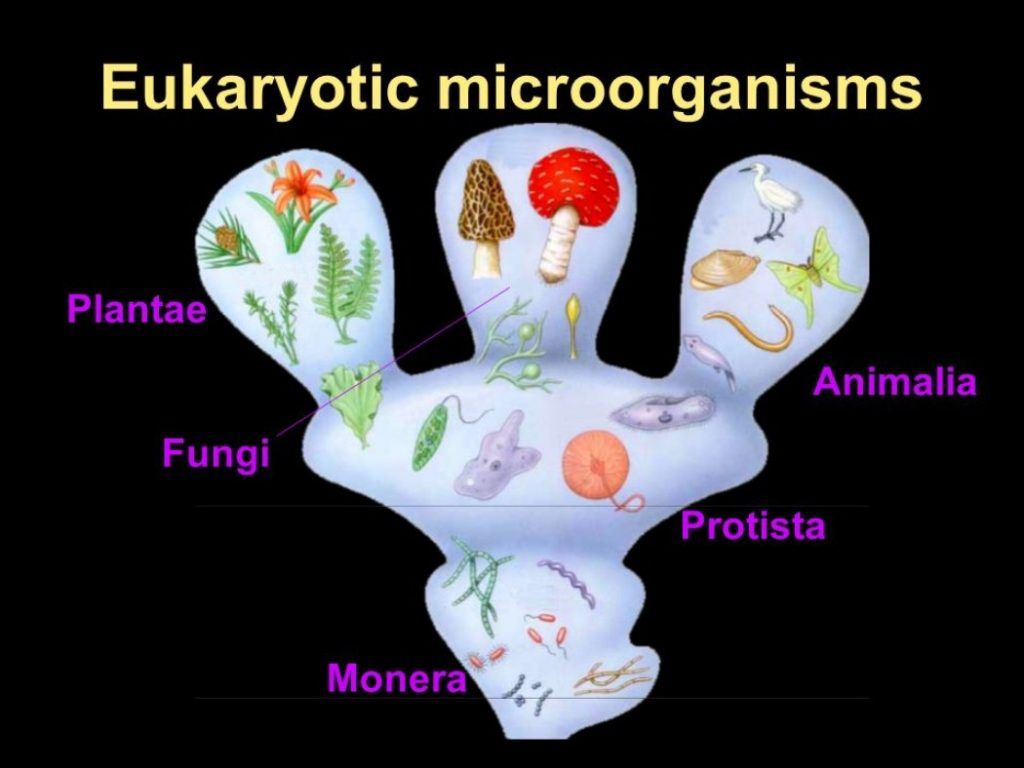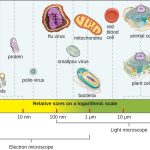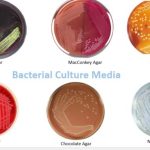The domain Eukarya contains all eukaryotes, including uni- or multicellular eukaryotes such as protists, fungi, plants, and animals. The major defining characteristic of eukaryotes is that their cells contain a nucleus.
Protists
Protists are unicellular eukaryotes that are not plants, animals, or fungi. Algae and protozoa are examples of protists.

Figure 4. Assorted diatoms, a kind of algae, live in annual sea ice in McMurdo Sound, Antarctica. Diatoms range in size from 2 μm to 200 μm and are visualized here using light microscopy. (credit: modification of work by National Oceanic and Atmospheric Administration)
Algae (singular: alga) are plant-like protists that can be either unicellular or multicellular (Figure 4). Their cells are surrounded by cell walls made of cellulose, a type of carbohydrate. Algae are photosynthetic organisms that extract energy from the sun and release oxygen and carbohydrates into their environment. Because other organisms can use their waste products for energy, algae are important parts of many ecosystems. Many consumer products contain ingredients derived from algae, such as carrageenan or alginic acid, which are found in some brands of ice cream, salad dressing, beverages, lipstick, and toothpaste. A derivative of algae also plays a prominent role in the microbiology laboratory. Agar, a gel derived from algae, can be mixed with various nutrients and used to grow microorganisms in a Petri dish. Algae are also being developed as a possible source for biofuels.
Protozoa (singular: protozoan) are protists that make up the backbone of many food webs by providing nutrients for other organisms. Protozoa are very diverse. Some protozoa move with help from hair-like structures called cilia or whip-like structures called flagella. Others extend part of their cell membrane and cytoplasm to propel themselves forward. These cytoplasmic extensions are called pseudopods (“false feet”). Some protozoa are photosynthetic; others feed on organic material. Some are free-living, whereas others are parasitic, only able to survive by extracting nutrients from a host organism. Most protozoa are harmless, but some are pathogens that can cause disease in animals or humans (Figure 5).

Figure 5. Giardia lamblia, an intestinal protozoan parasite that infects humans and other mammals, causing severe diarrhea. (credit: modification of work by Centers for Disease Control and Prevention)
Fungi
Fungi (singular: fungus) are also eukaryotes. Some multicellular fungi, such as mushrooms, resemble plants, but they are actually quite different. Fungi are not photosynthetic, and their cell walls are usually made out of chitin rather than cellulose.

Figure 6. Candida albicans is a unicellular fungus, or yeast. It is the causative agent of vaginal yeast infections as well as oral thrush, a yeast infection of the mouth that commonly afflicts infants. C. albicans has a morphology similar to that of coccus bacteria; however, yeast is a eukaryotic organism (note the nuclei) and is much larger. (credit: modification of work by Centers for Disease Control and Prevention)
Unicellular fungi—yeasts—are included within the study of microbiology. There are more than 1000 known species. Yeasts are found in many different environments, from the deep sea to the human navel. Some yeasts have beneficial uses, such as causing bread to rise and beverages to ferment; but yeasts can also cause food to spoil. Some even cause diseases, such as vaginal yeast infections and oral thrush (Figure 6).
Other fungi of interest to microbiologists are multicellular organisms called molds. Molds are made up of long filaments that form visible colonies (Figure 7). Molds are found in many different environments, from soil to rotting food to dank bathroom corners. Molds play a critical role in the decomposition of dead plants and animals. Some molds can cause allergies, and others produce disease-causing metabolites called mycotoxins. Molds have been used to make pharmaceuticals, including penicillin, which is one of the most commonly prescribed antibiotics, and cyclosporine, used to prevent organ rejection following a transplant.

Figure 7. Large colonies of microscopic fungi can often be observed with the naked eye, as seen on the surface of these moldy oranges.


